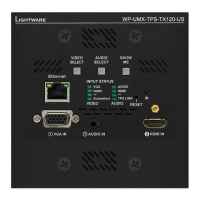3. Product Overview UMX-TPS-TX100 series – User's Manual 29
TPS Interface
The device is built with TPS (Twisted Pair Single) interface which are using HDBaseT
TM
technology. It means
the unit transmits video, audio, Ethernet, RS-232, and Infrared signals via a single CATx cable.
TPS Interface Working Modes
The TPS working mode between the transmitter and the receiver is determined by the mode set in them.
▪ Auto: The TPS mode is determined automatically.
▪ HDBaseT: Ideal for high resolution signals up to 4K.
▪ Long reach: Ideal for big distances up to 1080p@60Hz with extended cable lengths.
▪ LPPF1*: Only RS-232 communication is transmitted (@ 9600 baud).
▪ LPPF2*: Only RS-232 (@ 9600 baud) and Ethernet communication are transmitted.
* LPPF: Low Power Partial Functionality.
Selected mode on RX side
LPPF1 LPPF2 Long reach Auto
Selected mode
on TX side
LPPF1 LPPF1 LPPF1 LPPF1 LPPF1 LPPF1
LPPF2 LPPF1 LPPF2 LPPF2 LPPF2 LPPF2
LPPF1 LPPF2 HDBaseT Long reach HDBaseT
Long reach LPPF1 LPPF2 Long reach Long reach Long reach
Auto LPPF1 LPPF2 HDBaseT Long reach HDBaseT **
automatically. Long reach mode is not available when both sides are set to Auto mode.
are set to Auto mode, the source side is the initiator. It will negotiate each state transition with its sink side
partner.
in automatic mode. In this case, the mode transition negotiation is initiated by the host-managed device and
the auto-mode device follows through. The allowed cable lengths and resolutions are listed in the Maximum
Extension Distances section.
Port Diagrams
Standalone Extenders
operation is the same for the following models.
▪ UMX-TPS-TX120
▪ UMX-TPS-TX130
▪ UMX-TPS-TX140
▪ UMX-TPS-TX140-Plus
Port diagram of the UMX-TPS-TX140 transmitter
The device has four video input ports to receive analog video (VGA, DVI-A) and digital video (HDMI, DP,
5-pole Phoenix). The analog signals are converted to digital ones. The user can choose which audio signal
is transmitted on the TPS output port: one from the analog audio sources or the original embedded audio
INFO: The DVI-D input accepts HDMI signal with embedded audio as well.
Besides, the device has four different interfaces to control the unit itself or third-party devices: infrared (input
and output), RS-232, Ethernet, and GPIO.
HDMI in
VGA in
DP in
DVI in
Analog
audio in 1
Analog
audio in 2
Analog audio
Analog video
Digital video + Digital audio
Analog video
Analog audio
Digital audio
A/D converter
Digital audio
5:1 digital
A/V switch
Digital video + Digital audio
Digital video + Digital audio
Digital
audio
Digital video
TPS out
A/D converter
Embedder
A/D converter
A/D converter
3:1 digital
audio switch
De-embedder
Digital
audio

